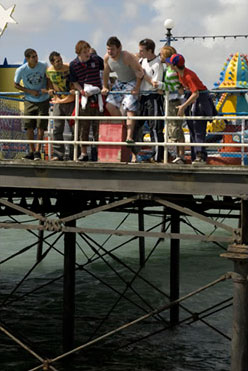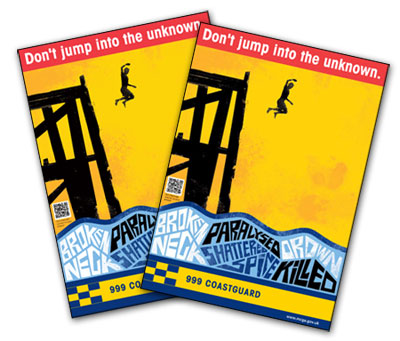Tombstoning – 'Don't jump into the unknown'

Tombstoning is an activity which has occurred around the coast for generations, unfortunately over recent years it has gained attention for the wrong reasons, with a number of people killed or seriously injured.
The title was adopted because of the way a person falls and plunges into deep water, in a similar way a stone would. This page offers some essential advice for those considering tombstoning and further resources for those wanting more information.
Why is it dangerous?
Tombstoning offers a high-risk, high-impact experience but it can have severe and life-threatening consequences. This is because:
- Water depths alter with the tide – the water may be shallower than it seems
- Submerged objects like rocks may not be visible – these can cause serious impact injuries
- The shock of cold water can make it difficult to swim
- Getting out of the water is often more difficult than people realise
- Strong currents can rapidly sweep people away
Who is harmed and what type of accidents happen?
Injuries and deaths as a result of tombstoning have been a problem. Over the five year period 2004-2008 - 139 incidents required a rescue or emergency response, 12 of these ended in a fatality.
We looked at 41 of the most serious cases in more detail, of these:
- Most of those involved in the most serious cases were male (85%)
- Teenagers were involved in just over half the cases (55%), followed by those in their 20s (25% with the remainder of incidents involving people aged over 30 years
- All of the known alcohol-related incidents involved males aged over 40 (which accounted for three of the fatal incidents)
- Of the non-fatal incidents, spinal and limb injuries (both at 20%) were most commonly reported.
Many of the non-fatal incidents have resulted in life-changing injuries and they required significant resources from the rescue services. Young and older fathers were among the fatalities, along with at least three teenagers. The coastguard has produced a video clip highlighting the consequences.
What can you do?
Don't jump into the unknown. Consider the dangers before you take the plunge:

- Check for hazards in the water. Rocks or other objects may be submerged and difficult to see
- Check the depth of the water. Remember tides can rise and fall very quickly
- As a rule of thumb, a jump of ten metres requires a depth of at least five metres
- Never jump whilst under the influence of alcohol or drugs
- Check for access. It may be impossible to get out of the water
- Consider the risks to yourself and others. Conditions can change rapidly – young people could be watching and may attempt to mimic the activity. And, if you jump when you feel unsafe or pressured, you probably won't enjoy the experience.
The best way to learn about the risks involved and have a good experience is to try coasteering - a mix of scrambling, climbing, traversing and cliff jumping around the coast with a professional guide.
Further information
RoSPA in partnership with the RNLI and MCA and members of the National Water Safety Forum have launched a campaign to help better inform those thinking about tombstoning at the coast this summer.